by Shaun McDougall, Forecast International.
The U.S. Navy last month delivered to Congress a $2.7 billion procurement wish list, above and beyond the service’s $44.3 billion procurement tab in the FY16 base budget and $418.8 million for procurement contained in the Overseas Contingency Operations account. The bulk of the funding in the unfunded priorities list would pay for additional F/A-18F Super Hornets and F-35C Joint Strike Fighters.
In a letter accompanying the list, Chief of Naval Operations Adm. Jonathan Greenert wrote that the FY16 budget request represents the “absolute minimum funding needed” for the Navy to support the current defense strategy. He said the service is taking on risk in three areas that could use additional resources: sensors and systems used to defeat air-to-air warfare and anti-ship cruise missile threats; strike fighter, logistics aircraft, and intelligence, surveillance and reconnaissance (ISR) capacity; and undersea warfare sensors and fire control systems. The unfunded priorities list contains funding for items in these areas.
The biggest items on the list are $1.2 billion for 12 F/A-18Fs and $1.0 billion for eight F-35Cs. Legacy strike fighters are reaching the end of their operational lives faster than planned, and the additional Super Hornets will offset potential shortfalls in the near term. Greenert also noted that the F/A-18Fs can be manufactured with the wiring and infrastructure to allow them to be converted to EA-18G Growler electronic attack aircraft in the future. He said this option would provide the Navy with the flexibility to bolster its Airborne Electronic Attack inventory as the service analyzes its Joint AEA mission requirements. The service included 22 EA-18Gs on its FY15 wish list, with lawmakers providing funding for 15 aircraft. The additional JSFs, meanwhile, would partially offset the Navy’s decision to remove 16 aircraft from the Future Years Defense Program due to budget constraints. Initial Operational Capability for the F-35C is planned for 2018.
The wish list also includes $65 million for one MQ-4C Triton unmanned air vehicle (UAV) and $187 million for two C-40A cargo aircraft. Another $170 million would pay for 170 counter electronic attack Block 2 kits, which would be outfitted on F/A-18E/F and EA-18G aircraft to counter sophisticated digital weapons and combat systems. The Navy also wants $60 million to buy a DDG 51 combat system shipset in FY16, which would allow for the modernization of an additional ship in FY18. The Surface Electronic Warfare Improvement Program (SEWIP) would get $28 million for two Block II advanced electronic detection systems, which would be outfitted on ships in FY18. The Navy also asks for $20 million for four TB-29X and four TB-34X submarine towed arrays.
Separately, the commander of U.S. Southern Command has asked for a leased vessel to serve as an Afloat Forward Staging Base. The Navy is configuring three Mobile Landing Platforms to serve as AFSBs, the first of which will be delivered in May.
For 50 years, Forecast International intelligence reports have been the aerospace and defense industry standard for accurate research, analysis, and projections. Our experienced analysts compile, evaluate, and present accurate data for decision makers. FI's market research reports offer concise analysis of individual programs and identify market opportunities. Each report includes a program overview, detailed statistics, recent developments and a competitive analysis, culminating in production forecasts spanning 10 or 15 years. Let our market intelligence reports be a key part of reducing uncertainties and mastering your specific market and its growth potential. Find out more at www.forecastinternational.com





